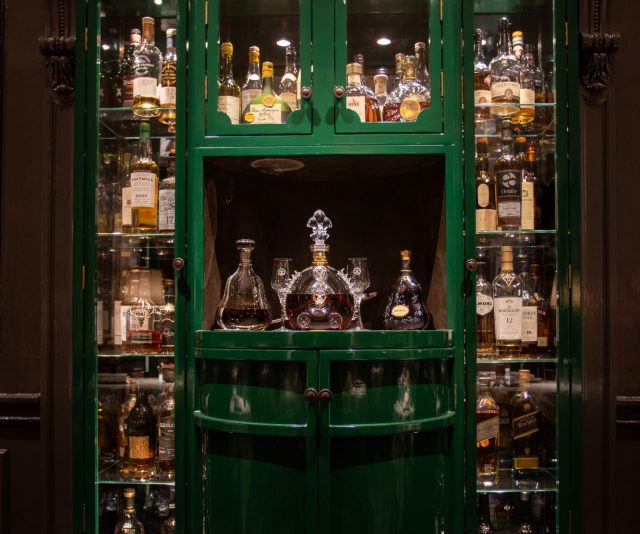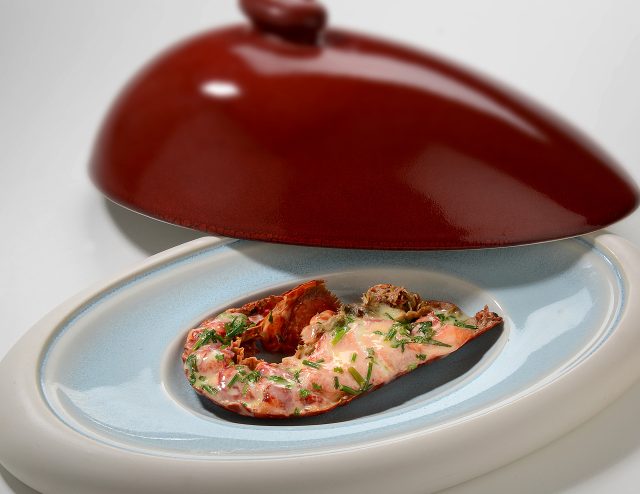This website uses cookies so that we can provide you with the best user experience possible. Cookie information is stored in your browser and performs functions such as recognising you when you return to our website and helping our team to understand which sections of the website you find most interesting and useful.
Wine List Confidential: Restaurant Andrew Fairlie
Douglas Blyde pays a visit to the late chef Andrew Fairlie’s eponymous restaurant, “set deep within the palace that is Gleneagles”. While there, he delves into the differing mark-ups on the wine list, and sees if the “big classic” main on the menu lives up to its reputation.

“Andrew Fairlie is rightfully credited with having transformed the culinary landscape of Scotland,” appraised Square Meal of the first Roux scholar, while Chitra Ramaswamy of The Times described the eponymous two-Michelin star restaurant,” being the only such garlanded restaurant in the country, “for achieving the unforgettable, with flawless food, atmosphere and service.”
Design
Revered yet comfortable, where guests “dress for their occasion” according to restaurant manager, Ross Hunter, rather than adhere to a sartorial code, Restaurant Andrew Fairlie is set deep within the palace that is Gleneagles, an AA five-red star rated property bestowed the “Art of Hospitality Award” by the inaugural World’s 50 Best Hotels, and currently ranked in 32nd position. Built by the Caledonian Railway Company nearly 100 years ago, and still served by a dedicated railway line, and with rail track motifs woven into the carpets, the 232-bedroom Grande Dame is equipped with three championship golf courses, a falconry centre, stables, a shooting ground, spar, and a shopping arcade including a well-stocked whisky merchant – as well as a duet of excellent bars amongst its 11 culinary outlets.
Always “a safe, organised working environment” according to energetic, fit, precise head sommelier, Frenk Trouw, Fairlie’s dining room features art by “dear friend of Chef Andrew”, Archie Forrest, “such as the charcoals of kitchen utensils.” However, most important to the team, including Michelin Guide Service Award-winning manager, Dale Dewsbury, in the role since day one, are the portraits of Fairlie, who is quirkily depicted before, and then after service, “which keeps him very much with us,” adds Trouw. There is also an oil painting of the restaurant’s original sommelier, Johnny Walker, praised as having “perhaps Scotland’s finest palate” by The Herald. Rachel Dein, meanwhile, created a bespoke piece featuring vegetables, herbs and fruit from the restaurant’s kitchen garden 10 to 20 minutes drive away depending which team member is at the wheel, on a legendary private estate. Indeed, it was at this walled, two-acre site replete with a polytunnel that Krug Clos d’Ambonnay 2000 was celebrated alongside a barbecue by lover of mature Champagnes, Fairlie in 2015.
Lighting is particularly effective, with glossy red-centred bowls, also featuring garden ingredients in their composition, reflecting, like candles, the spotlights from above.
Drinks
Born in Rotterdam to gastronomic parents who brought him willingly on culinary missions to four to five restaurants each week, Trouw first tasted wine at age 12. At 14, he landed his first role in hospitality, albeit one which initially saw him “cleaning toilets in a hotel, later bartending at an Irish pub, then becoming sommelier alongside [his] studies at Restaurant Prei, Amsterdam.” When Visa issues prevented a move to the USA, Trouw travelled instead to Scotland as part of an internship, working at Gleneagles’ very grand, pillared, original dining room, The Strathearn. There, he recalls “decanting baked beans and orange juice” during breakfast service. This venue has now become a destination in its own right, with is wine selection overseen by Master Sommelier, Matteo Montone, Group Wine Director at Maison Estelle Group and Gleneagles, and head sommelier, Paul Stibbles.

Trouw subsequently applied to Restaurant Andrew Fairlie in 2016. Although no position was available at the time, Dewsbury clearly observed attributes in Trouw, telling him, “I feel like I might regret saying no to you.” Well within the year that followed, Trouw worked his way from commis sommelier to assistant restaurant manager, “with a strong link to wine service” and in May 2021, he took on the mantel of head sommelier.
Up by 50 bins in a year, Trouw, who is supported by assistant sommelier, Marjan Houton, oversees a landscape format list reaching over 400 bins, which, despite the restaurant’s independent status within Gleneagles, share the hotel’s main cellar where bottles are lit in a subtly cooler white than those for other outlets. Although Trouw notes there is little need to offer a list of 1,000 bins “because many guests would either get lost or just give up because they are ready to start dinner,” he has instigated a structured approach to buying, with an eye on the future, given “no one bothered with allocations or bought in bond before.”
True to Trouw’s origins, expect to encounter the odd bottle by a Dutch winemaker. “I’ve always been a great fan of the wines of Carel Voorhuis, made at Domaine d’Ardhuy, including his stunning 2005 Clos de Vougeot,” he says.
Mark-ups can be eye-watering, reaching six times retail on bottles such as, at the lower end, Ben Glaetzer’s Amon-Ra 2003, while Sassicaia 2012 is quadrupled, and very top echelon bottles such as Domaine de la Romanée-Conti Grands Echezeaux 2002, tend to simply double in price. By contrast, several editions of Jacques Selosse Champagne, reserved for true dedicates of this grower, can come in close to retail. On the rare occasion a guest questions pricing, Trouw gently reminds them of the milieu. “Look around you, at this beautiful restaurant, the huge team, with owners who don’t live excessively. Every listing is considered and right in its drinking window.” These may include Barbaresco from the 1970s and Bordeaux from the 1980s and 1990s. “And we recently upgraded to Riedel Veloce glassware,” he adds.
While Champagne, including the notably fast-moving Krug selection, prescribed on each of the wine flights, dominates in sparkling terms, we understand a library of often mature bottles from 10 award-winning English producers is incoming. Although not pursuant of esoteric wines, you will find the occasional oddity on Trouw’s list, such as Hans Herzog’s Zweigelt from Marlborough, which delights Swiss guests. And on our visit, Trouw unknowingly brought a wine from Georgia the country, being Bedoba Saperavi, to the table of guests from Georgia, the North American state, much to their amusement. Meanwhile, best forget orange wines “which don’t work with our style of cooking” nor overtly “natural” wines which, says Trouw, can “smell like something decomposing.” Hence, “if you want trendy things, go to a wine bar!” he advises.
Be sure to visit the hotel’s David Collins Studio-designed American Bar before dinner for a Tuscan, Serbian, or Macedonian gin martini, served in a bespoke glass designed by Richard Brendon to keep the olive steady, or the pillared Century Bar for its brand new “The Great Adventure Book” menu, including a Champagne cocktail evoking the enticing scent of freshly fried fish ‘n’ chips.
Dishes
Adhering to the motto, “simple food, brilliantly done” dishes are enacted by a team led by head chef, Stephen McLaughlin, who worked with Fairlie for a quarter of a century, “and you can very clearly see his inspiration,” notes Trouw.
Equipped with multiple Coravin instruments, Trouw played us a very strong wine game tonight, beginning with the prism that is Krug Grande Cuvée 171ème Édition alongside canapés including oyster leaf with fennel and caviar, a Comte gougère dusted in chive powder, the tomato and gordal olive tart with saffron and marigold “confetti”, and comforting curried espuma concealing smoked haddock with dill oil served on a cool, magnetic, slanted cup.
With a tartare formed of 32 days aged chateaubriand, rump and fillet, lightly torched, then hand cut into tangible morsels scented with a very gently mezcal pepped Bloody Mary sauce, Trouw whose favourite wine book is Stalin’s Wine Cellar “which a guest brought me”, paired mineral, sleek but not withered Châteauneuf-du-Pape from 1972. Served, accurately given the profile, in a Pinot Noir/Nebbiolo Riedel, this rare, , refined, rosy Grenache Noir had, said Trouw, been aged in concrete vats for 48 years until it was “re-crafted” by eminent consultant, Xavier Vignon.
Next came “the big classic” according to Trouw: a lobster from Scotland’s cool, northerly waters, whose shell had been cold smoked over oak, with the supple flesh gently steamed for three to four minutes before being replaced in the scented body. This was bathed in perky, drinkable lemon and lime butter. Trouw selected more Krug, being vintage 2006, bringing exciting sparky notes to the exceptional dish, adhering to the words of tonight’s senior sous chef, Russell Plowman, 12 years with the restaurant: “let ingredients speak for themselves”. In lesser establishments than Restaurant Andrew Fairlie, such words might be easier uttered than enacted.

For the main course, a dry salt-cured, gently peppery grouse shot in the Scottish Borders in carcass juice with heart pâté and liver croquette met the “dirty” in a good way, 2005 Echezeaux from Domaine J. Confuron Cotetidot’s own, whole bunch, “Pinot Confuron” clone. Trouw rates grouse at this point in the season. Taken too early, it can taste “like chicken”, he says, while presently, the bird is still benefitting from eating the fruits of the landscape. This pairing of sanguine, slightly ashen, slightly bloody wine with the bird mirroring those aspects perfectly demonstrated Trouw’s modus operandi, being “I follow the food.”
Finally, an apricot souffle with hazelnut financier and lemon thyme ice cream was paired with, in colour and taste, apricot evoking Tokaji in the form of ÁTS six puttonyos Pince Aszú from a producer “focusing on the Western palate”, said Trouw.
Final word
In early 2019, Andrew Fairlie left this mortal coil at just 55 years old after suffering from a brain tumour. However, this dining room is not a stiff mausoleum to the great man. Its cohesive team make it a vivid, uplifting and joyful homage instead. It is also extremely successful, with the restaurant having achieved its highest revenue to date in the previous two months, with the clientele actually pushing for the top-end drinks pairing at £425, says Trouw, including “serious wines with amazing stories specifically chosen because they work with dishes rather than because they look good on paper.”
Two figures of Michelin mascot, Bibendum form the centrepieces of the pass, yet tonight’s meal had delivered, with generosity, skill, and impeccable sourcing, a truly standout experience worthy, in our humble opinion of “a special journey” rather than a mere “detour”.
Best for
- Krug selection/collection
- Barbaresco and Barolo
- Adelphi single malt collection
Value: 89, Size: 93, Range: 93, Originality: 91, Experience: 100; Total: 93.2
Restaurant Andrew Fairlie – The Gleneagles Hotel, Auchterarder PH3 1NF; 01764 694267; andrewfairlie.co.uk; reservations@andrewfairlie.co.uk
Related news
Burgundy 2023 en primeurs: cautious optimism
SWR: lighter bottles for entry level wines is 'the wrong message'
Ribera del Duero challenges 'out of date' perceptions in UK market

